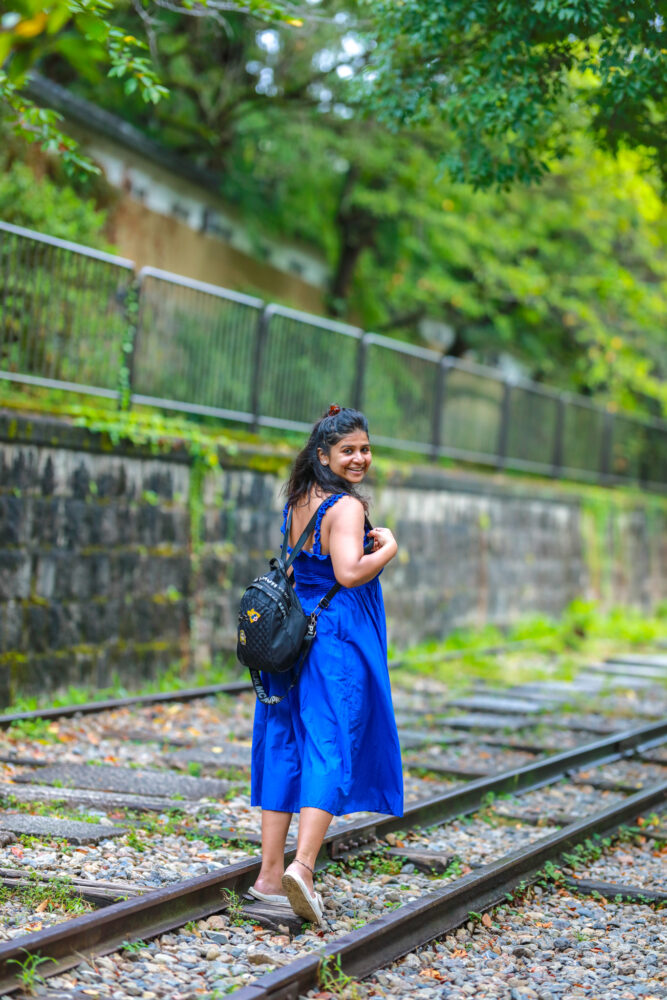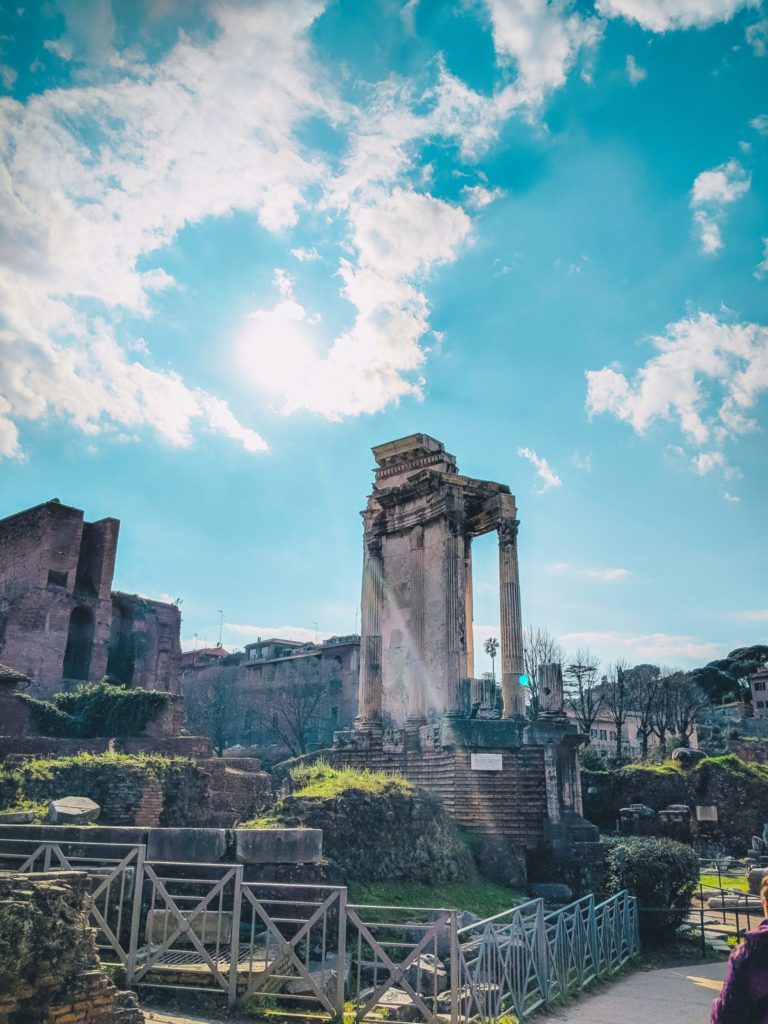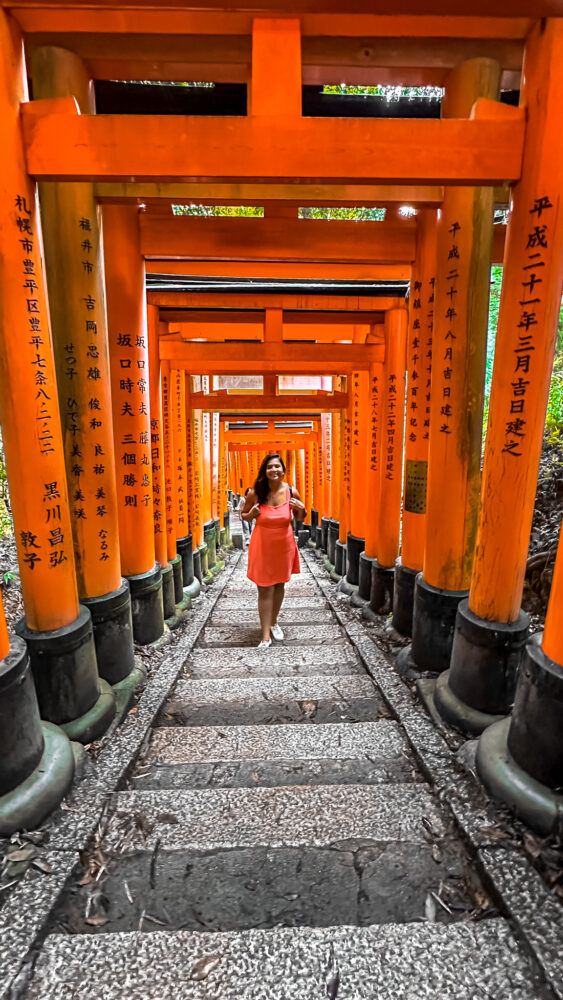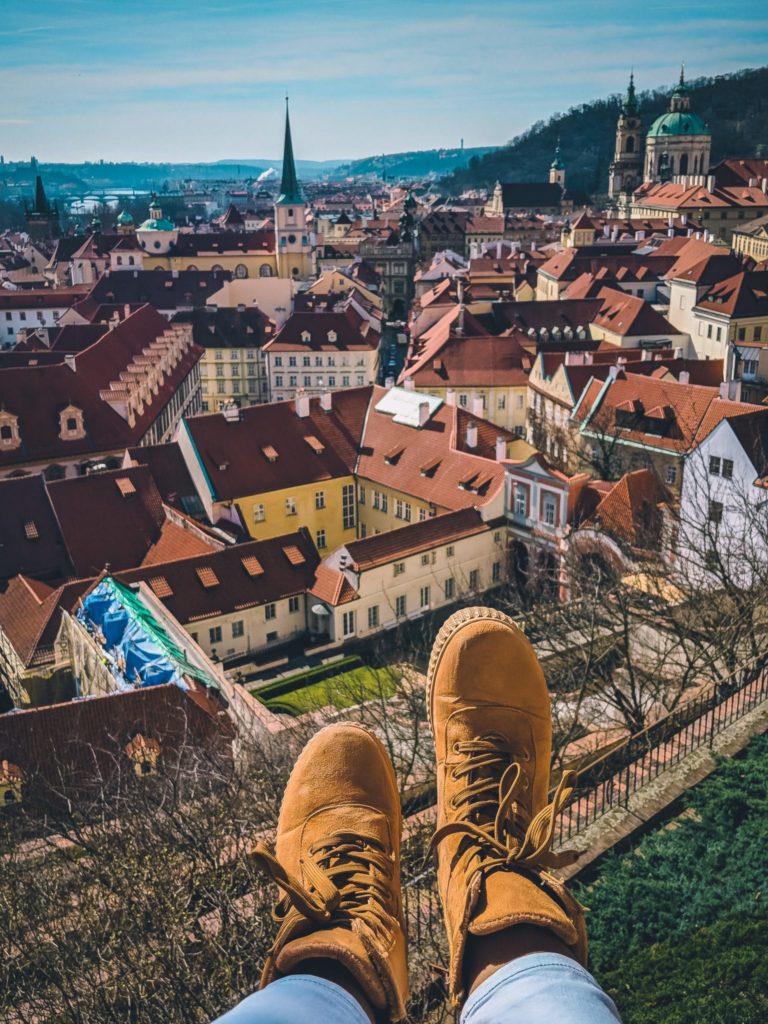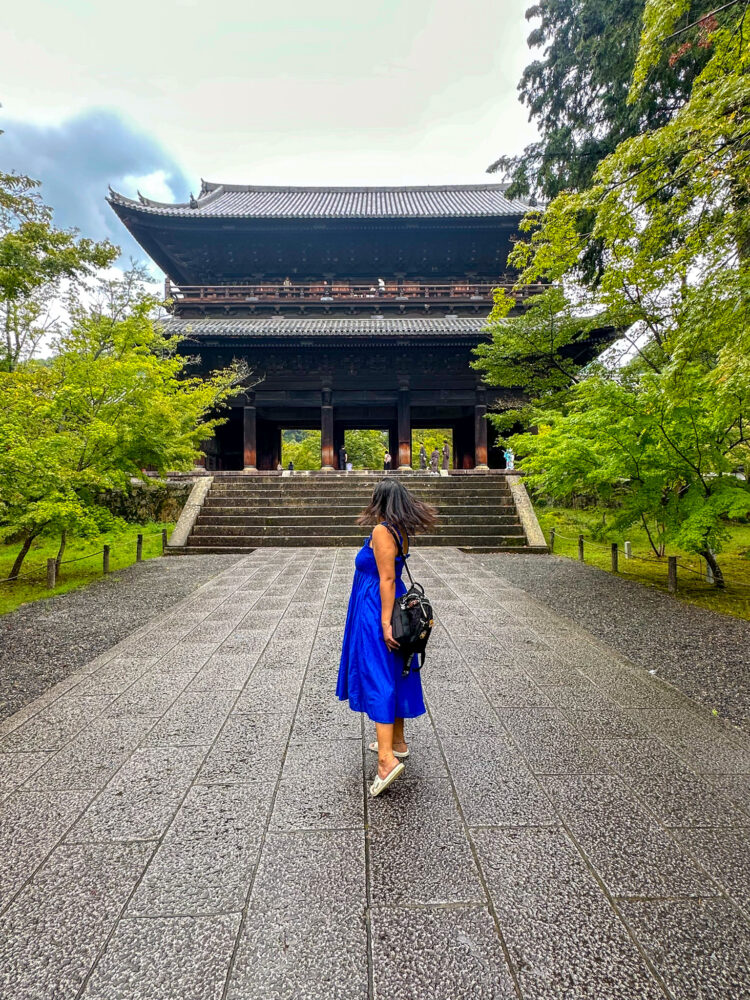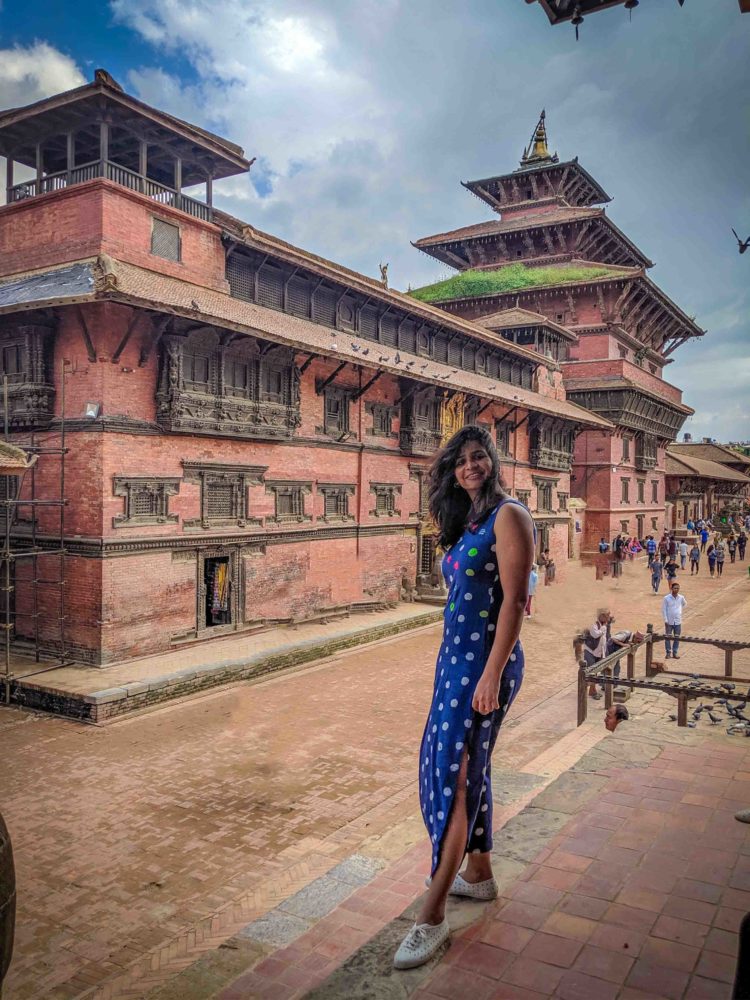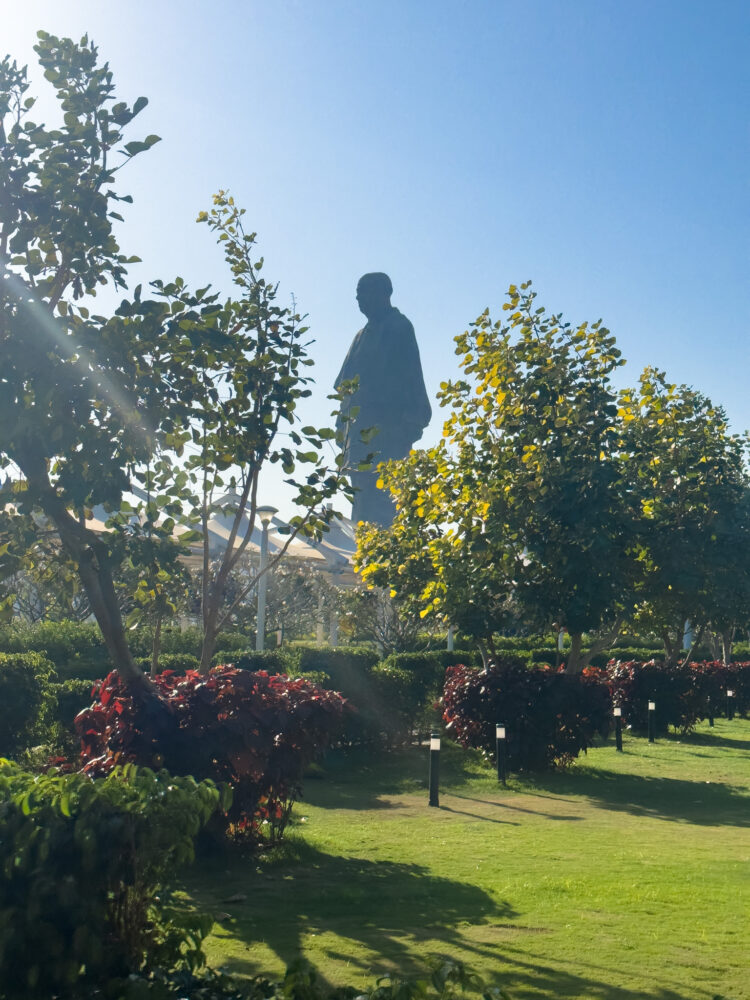Kyoto itinerary
From 794 to 1868, Kyoto was the capital of Japan and home to the emperor. Today, it’s among the top ten largest cities in the country, boasting a population of 1.5 million and a contemporary appearance. Throughout its history, Kyoto faced destruction from numerous wars and fires. However, its remarkable historical significance led to its removal from the atomic bomb target list during World War II, sparing it from devastation. As a result, a vast array of temples, shrines, and other invaluable historical buildings remain intact in the city.
Central Kyoto
Nijo castle
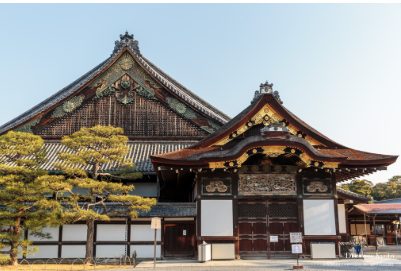 Constructed in 1603, Nijo Castle served as the Kyoto abode for Tokugawa Ieyasu, the inaugural shogun of the Edo Period (1603-1867). Twenty-three years later, Ieyasu’s grandson, Iemitsu, finished the palace structures and enhanced the castle by incorporating a five-story keep. The palace buildings of Nijo Castle are considered among the finest remaining specimens of Japan’s feudal castle palace design. Recognizing its historical significance, the castle was named a UNESCO World Heritage site in 1994. Nijo Castle is composed of three distinct sections: the Honmaru, which is the primary defensive zone, the Ninomaru, serving as the secondary line of defense, and the gardens that encompass these areas. Both the entire castle premises and the Honmaru are encircled by protective stone walls and moats. The entry fee is 800 yen and additional 500 yen for Ninomaru palace.
Constructed in 1603, Nijo Castle served as the Kyoto abode for Tokugawa Ieyasu, the inaugural shogun of the Edo Period (1603-1867). Twenty-three years later, Ieyasu’s grandson, Iemitsu, finished the palace structures and enhanced the castle by incorporating a five-story keep. The palace buildings of Nijo Castle are considered among the finest remaining specimens of Japan’s feudal castle palace design. Recognizing its historical significance, the castle was named a UNESCO World Heritage site in 1994. Nijo Castle is composed of three distinct sections: the Honmaru, which is the primary defensive zone, the Ninomaru, serving as the secondary line of defense, and the gardens that encompass these areas. Both the entire castle premises and the Honmaru are encircled by protective stone walls and moats. The entry fee is 800 yen and additional 500 yen for Ninomaru palace.
Timings: The timings are from 8:45 am to 5 pm. The Ninomaru palace remains close on Tuesday in the months of January, July, August, December.
Location: 541 Nijojocho, Nakagyo Ward, Kyoto, 604-8301, Japan
Getting there: The entrance to Nijo Castle is conveniently located just a short walk from the Nijojo-mae Station on the Tozai Subway Line. To get there from Kyoto Station, you can take the Karasuma Subway Line to Karasuma-Oike Station, then switch to the Tozai Line, heading to Nijojo-mae Station. This journey typically takes around 15 minutes and costs 260 yen. Alternatively, the castle is accessible from Kyoto Station via Kyoto City Bus numbers 9 or 50 (a 15-20 minute ride costing 230 yen one way), or from Shijo-Kawaramachi using Kyoto City Bus number 12 (a 15-minute trip also costing 230 yen one way).
Kyoto railway museum
Opened in 2016 by JR West, the Kyoto Railway Museum is situated on the site that previously hosted the Umekoji Train and Locomotive Museum, located roughly twenty minutes by foot to the west of Kyoto Station. It stands as one of the top three railway museums in Japan, alongside JR East’s Railway Museum in Saitama and JR Central’s SCMAGLEV and Railway Park in Nagoya. Spanning three floors across a 30,000 square meter area, the museum showcases a collection of over 50 decommissioned trains, ranging from historic steam locomotives to contemporary electric trains and Shinkansen. Additionally, visitors have the unique opportunity to walk underneath a former freight locomotive to explore its internal mechanics. The entry fee is 1500 and is it is purchased via klook then it will cost 1200.
Timings: The timings are from 10 am to 5 pm and is closed on Wednesday
Location: Kankijicho, Shimogyo Ward, Kyoto, 600-8835, Japan
Getting there: The Kyoto Railway Museum is conveniently located just a short distance from Umekoji-Kyotonishi Station, reachable in a mere 3-minute journey costing 150 yen one way from Kyoto Station. Alternatively, it’s a 20-minute stroll from Kyoto Station
Sento imperial palace

Situated opposite the Kyoto Imperial Palace within the Kyoto Imperial Park, Sento Imperial Palace is an auxiliary palace complex. Established in 1630, it served as the retirement residence for Emperor Gomizuno and later for other retired emperors. To visit Sento Imperial Palace, one must participate in a complimentary guided tour offered by the Imperial Household Agency. The tour includes a walk through the palace’s garden, featuring the North Pond and South Pond areas, showcasing an exquisite strolling garden design. These tours, lasting approximately one hour, are conducted exclusively in Japanese. However, audio guides in various foreign languages are available for non-Japanese speakers. Tickets should be booked in prior with passport on the official website.
Timings: The timings are from 8:40 am to 5 pm and Mondays are closed.
Location: Kyotogyoen, Kamigyo Ward, Kyoto, 602-0881, Japan
Getting there: Sento Imperial Palace is situated in Kyoto Imperial Park and is accessible from Kyoto Station in roughly 10 minutes via the Karasuma Subway Line. Alight at either Marutamachi or Imadegawa Station, with both stations being approximately a 15-minute walk away from the entrance gate of the palace.
Nishiki market
 Nishiki Market boasts a welcoming yet bustling vibe, perfect for those eager to delve into Kyoto’s renowned culinary scene. The market features a range of shops, from tiny, compact stalls to more expansive two-story establishments. Each store typically focuses on a specific kind of food, with the majority of items on offer being locally sourced and produced. Often referred to as “Kyoto’s Kitchen,” this vibrant commercial market is a hub for food-related items, including fresh seafood, vegetables, knives, and cookware. It’s an ideal spot for discovering seasonal delicacies and Kyoto’s unique food items such as traditional Japanese sweets, pickles, dried seafood, and sushi.The entry to this place is free.
Nishiki Market boasts a welcoming yet bustling vibe, perfect for those eager to delve into Kyoto’s renowned culinary scene. The market features a range of shops, from tiny, compact stalls to more expansive two-story establishments. Each store typically focuses on a specific kind of food, with the majority of items on offer being locally sourced and produced. Often referred to as “Kyoto’s Kitchen,” this vibrant commercial market is a hub for food-related items, including fresh seafood, vegetables, knives, and cookware. It’s an ideal spot for discovering seasonal delicacies and Kyoto’s unique food items such as traditional Japanese sweets, pickles, dried seafood, and sushi.The entry to this place is free.
Timings: The timing is 10 am to 6 pm and the closing days vary but usually its on Wednesdays or Sundays.
Location: Nakagyo Ward, Kyoto, 604-8055, Japan
Getting there: Nishiki Market street is conveniently located just one block north and parallel to Shijo Avenue. It’s a brief, less than five-minute walk from Shijo Station on the Karasuma Subway Line, which is a 4-minute, 220 yen ride from Kyoto Station. Alternatively, the market is also accessible from either Karasuma or Kyoto-Kawaramachi stations on the Hankyu Line.
Pontocho
Pontocho stands out as one of Kyoto’s most charming and ambient areas for dining. This slender lane, stretching from Shijo-dori to Sanjo-dori and located a block west of the Kamogawa River, is lined with a diverse array of restaurants. These establishments range from budget-friendly yakitori spots to places serving both traditional and contemporary Kyoto dishes, various international cuisines, and some highly exclusive venues that necessitate both connections and a substantial budget.
Timings: The timings are usually from 5 pm to 11 pm due to business hours befor
Location: Japan, 〒604-8015 Kyoto, Nakagyo Ward, Nabeyacho, 211-3
Getting there: To reach Pontocho, the nearest bus stop is Shijo Kawaramachi, accessible via several bus routes, such as lines 17 and 205 that originate from Kyoto Station. For train access, the closest stations are Kyoto-Kawaramachi Station on the Hankyu Line and Shijo Station on the Keihan Line.
Nijo Jinya
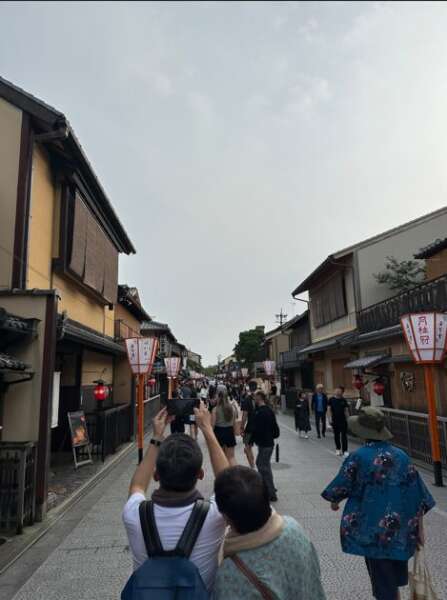 Nijo Jinya, once an inn for daimyo (feudal lords) visiting Kyoto in the feudal era, was designed with their safety in mind. The building features a range of security measures, including concealed passages, trapdoors, secret escape routes, and various other protective devices. Tours of this fascinating establishment are conducted exclusively in Japanese. Visitors who do not speak Japanese are encouraged to bring along a Japanese-speaking friend or guide. The entry fees is 1000 yen per person.
Nijo Jinya, once an inn for daimyo (feudal lords) visiting Kyoto in the feudal era, was designed with their safety in mind. The building features a range of security measures, including concealed passages, trapdoors, secret escape routes, and various other protective devices. Tours of this fascinating establishment are conducted exclusively in Japanese. Visitors who do not speak Japanese are encouraged to bring along a Japanese-speaking friend or guide. The entry fees is 1000 yen per person.
Timings: The tour held daily except Wednesdays and the timings are 11:30, 1:30 and 3:00.
Location: 137 Sanboomiyacho, Nakagyo Ward, Kyoto, 604-8316, Japan
Getting there: Nijo Jinya is situated within a residential zone, not far from Nijo Castle. This site is marked on the English-language maps available from the Kyoto Tourist Offices. The nearest subway station is “Nijojo-mae Station” on the Tozai Line.
Dotonbori
Kyoto tower
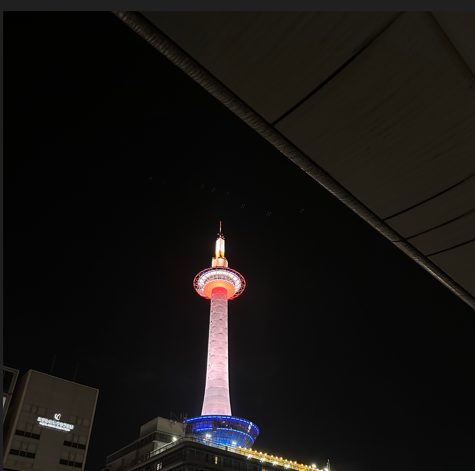
Kyoto Tower, towering at a height of 131 meters and situated opposite Kyoto Station, is the tallest building in Kyoto. This modern landmark, contrasting the city’s renowned historical temples and shrines, was completed in 1964. This was a significant year, marking the inauguration of the Shinkansen and the Tokyo Olympics. The tower features an observation deck 100 meters above the ground, offering panoramic views of Kyoto and, on clear days, extending as far as Osaka. The structure is mounted on a conventional commercial building, which houses a variety of souvenir shops, eateries, and a hotel. The entrance fee to this over the top place is 800 Yen.
Timings: The timings are from 10:30 to 10 pm and there are no closing days.
Location: 721-1 Higashishiokojicho, Shimogyo Ward, Kyoto, 600-8216, Japan
Getting there: It is very near by to the Kyoto station as this sightseeing place is situated in north of the Kyoto station.
Kyoto station
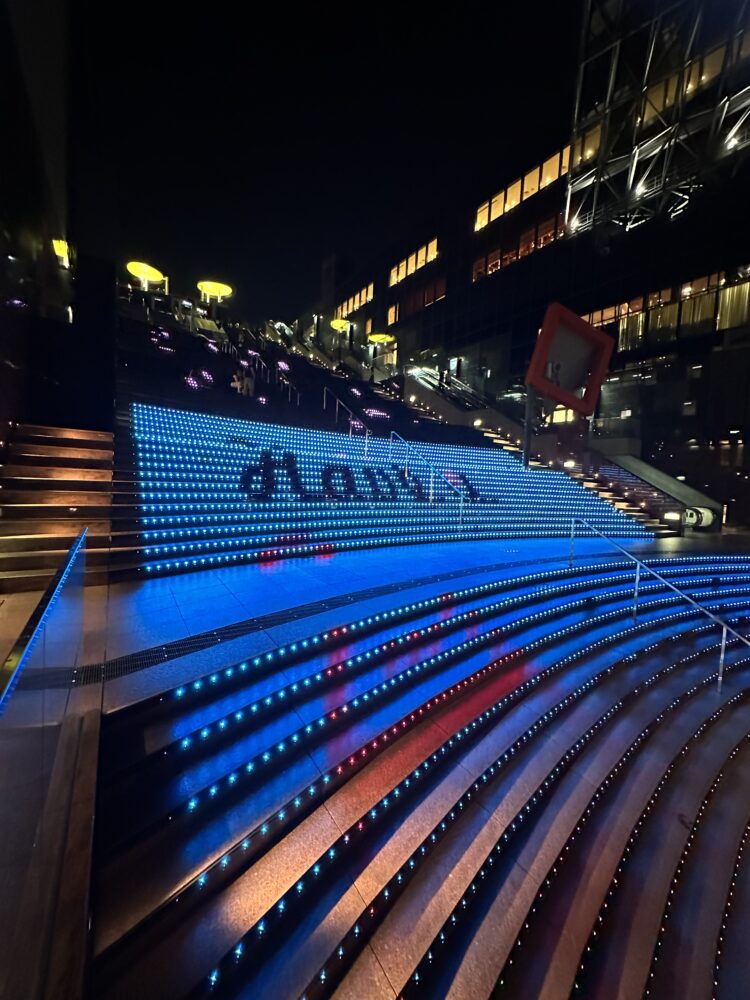
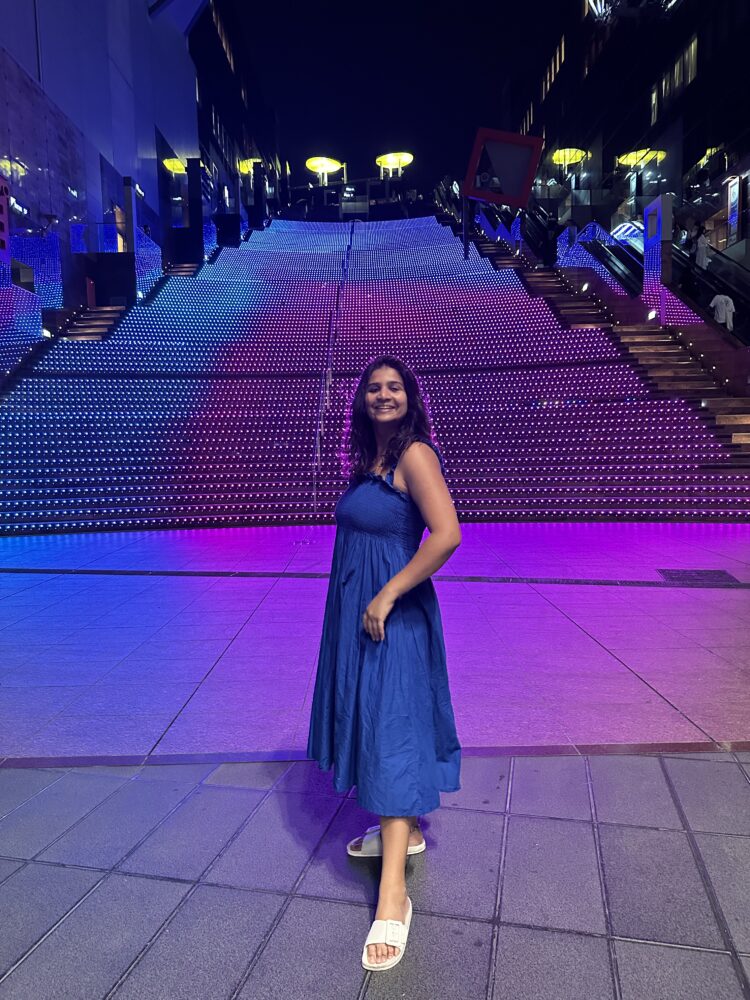
Constructed to commemorate the 1200th anniversary of Kyoto’s establishment as the capital, Kyoto Station’s building was unveiled in 1997. It presents a stark contrast to the conventional perception of Kyoto as a hub of traditional Japanese culture, especially among international visitors. The building’s avant-garde architecture, a brainchild of the Japanese architect Hara Hiroshi, embodies an attempt to blend historical Kyoto with contemporary design elements. The primary feature of the station is its expansive main hall, known as the Matrix, which showcases a roof with visible steel beams. This design not only mirrors the station’s own architecture but also symbolizes the grid pattern of Kyoto’s streets.
Timings: There are no particular timings to visit this place.
Location: Higashishiokoji Kamadonocho, Shimogyo Ward, Kyoto, Japan
Getting there: As the primary railway hub in the city, Kyoto Station accommodates all train services from Japan Railways, including the Shinkansen, as well as those from Kintetsu Railway and the Karasuma Subway Line. In front of the station building, there’s also a significant bus terminal.
Kyoto aquarium
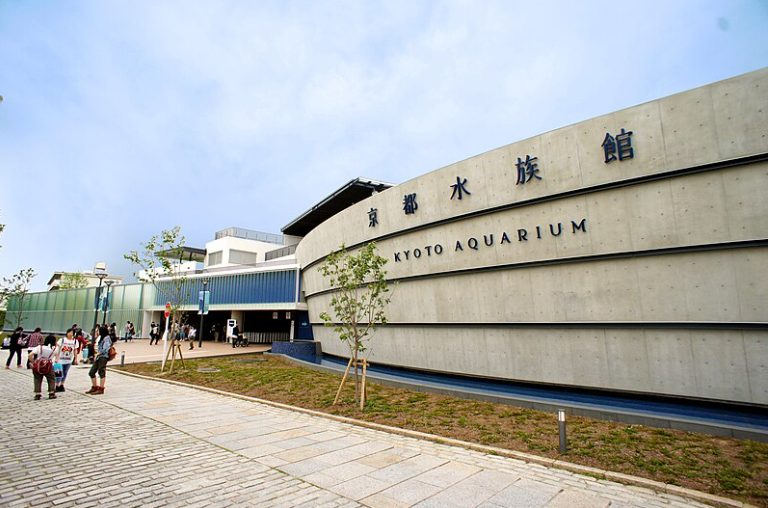
Opened in 2012, Kyoto Aquarium, located in Umekoji Park roughly a kilometer west of Kyoto Station, is a contemporary and well-designed facility, though smaller in scale compared to Japan’s leading aquariums. This two-story establishment is segmented into various thematic zones, each showcasing a diverse array of aquatic creatures. A notable feature of the aquarium is a dedicated area that simulates the river ecosystems of Kyoto, complete with Japanese giant salamanders. The facility is also actively involved in the conservation and breeding of several endangered local aquatic species. Apart from this, visitors can explore exhibits featuring marine life from around the globe, including jellyfish, penguins, and seals. Additionally, the aquarium hosts several dolphin shows daily at its dolphin stadium.
Timings: The timings are 10 am to 5 pm though opening hours might vary by day.
Location: 35-1 Kankijicho, Shimogyo Ward, Kyoto, 600-8835, Japan
Getting there: Located in Umekoji Park, Kyoto Aquarium is a 15-minute stroll to the west of Kyoto Station, or it can be reached in just five minutes from Umekoji-Kyotonishi Station. The latter is a brief 3-minute journey from Kyoto Station, costing 150 yen for a one- trip.
Kyoto Manga Museum
The Kyoto International Manga Museum, which opened its doors in 2006, spans three floors and a basement, with its walls predominantly adorned with manga shelves. One of the key highlights for visitors is perusing this extensive manga collection. While a modest portion of the collection includes foreign and translated manga, the bulk of it is in Japanese. Besides its impressive array of local manga, the museum also emphasizes the global proliferation and evolution of manga. The entry fee to the museum is 900 yen.
Timings: The timings to visit this museum is 10:30 to 5:30 pm and it is usually closed on Tuesdays and Wednesdays.
Locations: 452 Kinbukicho, Nakagyo Ward, Kyoto, 604-0846, Japan
Getting there: Situated just a two-minute walk from Karasuma-Oike Station, the Kyoto International Manga Museum is easily accessible. It’s a brief 5-minute subway ride on the Karasuma Line from Kyoto Station, costing 220 yen.
Honganji temples

Nishi Honganji and Higashi Honganji, two prominent temples located in Kyoto’s central area, serve as the main temples for the two branches of the Jodo-Shin Sect, also known as the True Pure Land Sect. This sect is among the most widely followed Buddhist traditions in Japan, and these temples offer an excellent opportunity to observe modern Japanese Buddhism.
Timings: The timings for Nishi Hoganji is from 5:30 am to 5 pm and the timings for Higashi Hoganji is from 5:50 to 5:30 from march to October and November to February timing is 6:20 to 4:30.
Location: Japan, 〒600-8505 Kyoto, Shimogyo Ward
Getting there: The Honganji temples is just 15 to 20 minutes of walk from the north of Kyoto station.
Eastern Kyoto
Kiyomizudera
Kiyomizudera, celebrated as one of Japan’s most iconic temples, was established in 780 near the Otowa Waterfall amidst the lush hills to the east of Kyoto. Its name is inspired by the pure water of the waterfall. The temple is famously known for its wooden terrace extending from the main hall, standing 13 meters above the hillside. This terrace offers splendid views of the vibrant cherry and maple trees that bloom spectacularly in spring and autumn, as well as panoramic views of Kyoto city in the distance. The admission fee is 400 Yen.

Timings: The timings are from 6 am to 6 pm from July to August and after that timings extend till 9 pm.
Location: 1 Chome-294 Kiyomizu, Higashiyama Ward, Kyoto, 605-0862, Japan
Getting there: To reach Kiyomizudera from Kyoto Station, you can take bus number 206, which takes about 15 minutes and costs 230 yen. Alight at either the Gojo-zaka or Kiyomizu-michi bus stop, and from there, it’s a ten-minute walk uphill to the temple. Another option is to walk for approximately 20 minutes from Kiyomizu-Gojo Station, located on the Keihan Railway Line.
Higashiyama
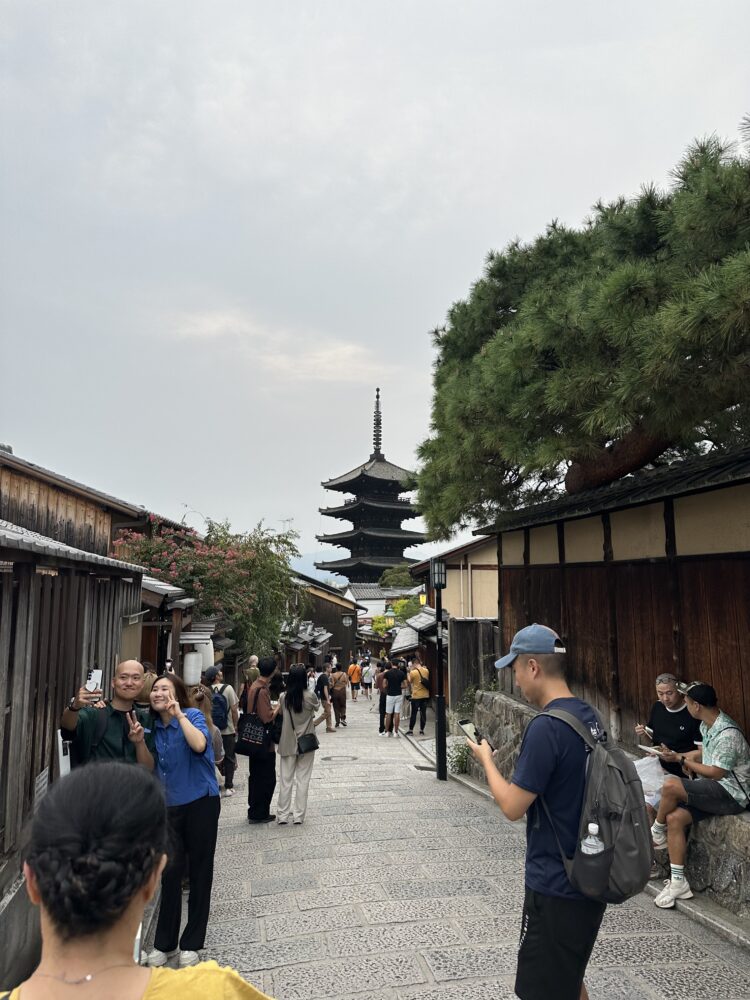
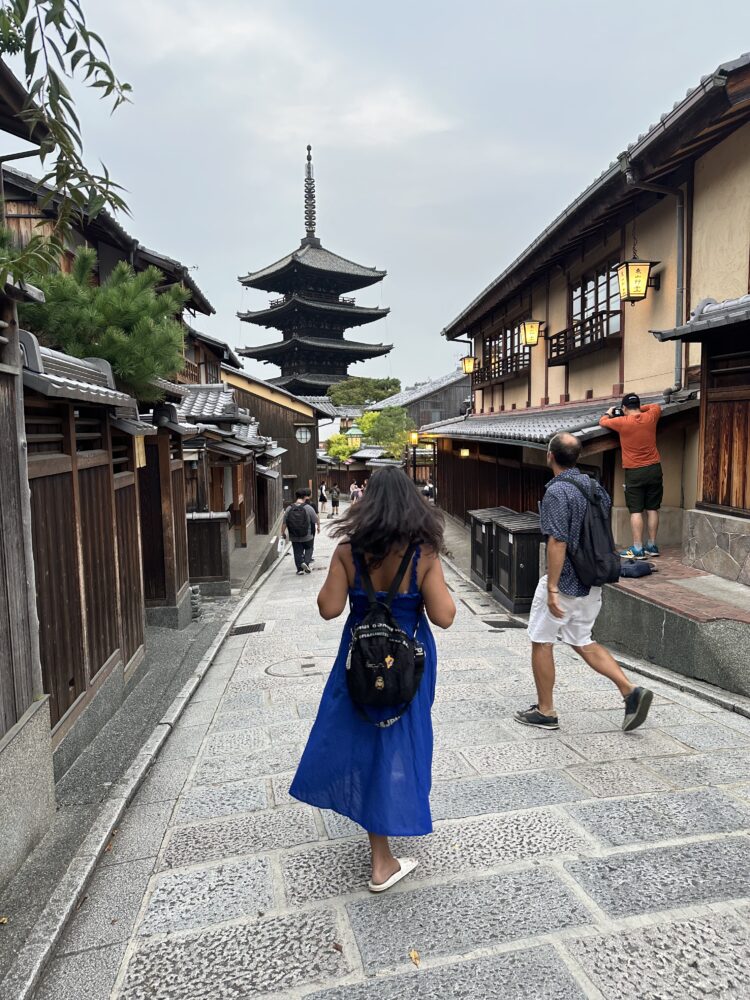
Situated along the lower slopes of the eastern mountains of Kyoto, the Higashiyama District stands out as one of the city’s most well-maintained historical areas. It offers an authentic glimpse into ancient Kyoto, particularly in the stretch between Kiyomizudera and Yasaka Shrine. This area is characterized by its narrow alleys, wooden structures, and classic merchant stores, which collectively recreate the ambiance of the old capital. Recent initiatives, including the removal of telephone poles and the renovation of the streets, have further enhanced the district’s traditional atmosphere.
Timings: There is no particular timing to visit this district.
Location: It is a district in Kyoto
Getting there: To get to the Higashiyama District from Kyoto Station, board bus number 206 heading towards Kiyomizudera. You can alight at any of the stops between Gojozaka (a 10-minute ride costing 230 yen) and Gion (which takes 15 minutes and also costs 230 yen). Alternatively, the district is within a 10-15 minute walking distance from several stations: Kiyomizu-Gojo and Gion-Shijo on the Keihan Line, Kyoto-Kawaramachi on the Hankyu Line, or Higashiyama Station on the Tozai Subway Line.
Ginkakuji
Ginkakuji, a Zen temple, is situated in the Higashiyama area along the eastern mountains of Kyoto. Originally, in 1482, Shogun Ashikaga Yoshimasa established his retirement villa on this site, taking inspiration from Kinkakuji (Golden Pavilion), which was his grandfather’s retirement villa located at the foothills of Kyoto’s northern mountains, Kitayama. Presently, Ginkakuji is comprised of the Silver Pavilion and about half a dozen other temple structures, along with a stunning moss garden and an extraordinary dry sand garden. Visitors can appreciate these features by following a designated circular path around the temple grounds, offering varied views of the gardens and architectural structures. The admission fee is 500 Yen.
Timings: The timings to visit this place is 8:30 to 17:00 (March to November) and 9:00 to 16:30 for December to February.
Location: 2 Ginkakujicho, Sakyo Ward, Kyoto, 606-8402, Japan
Getting there: You can reach Ginkakuji directly using bus number 5 or 17 from Kyoto Station, which takes approximately 35-40 minutes and costs 230 yen for a one-way trip. Another option is to walk to Ginkakuji along the Philosopher’s Path starting from Nanzenji, a journey that typically takes between 30 to 45 minutes.
Kyoto national museum
Established in 1897, the Kyoto National Museum ranks as one of Japan’s most historic museums and is among the nation’s four premier national museums, sharing this distinction with the Tokyo National Museum, Nara National Museum, and Kyushu National Museum. The museum showcases its permanent collection only during limited times throughout the year, featuring an extensive range of cultural artifacts. These include archeological finds, sculptures, ceramics, calligraphy, traditional costumes, and paintings. For most of the year, the museum hosts special thematic exhibitions. When there are no exhibitions, only the museum’s garden remains accessible to visitors. The regular exhibition charges are 700 Yen, the special one is 1500 and visiting only garden then it is 300.
Timings: The entry charges are during special exhibitions is 9:00 to 17:30 (until 20:00 on Fri and Sat) and during regular exhibitions and between exhibitions: 9:30 to 17:00.
Location: 527 Chayacho, Higashiyama Ward, Kyoto, 605-0931, Japan
Getting there: Situated right opposite Sanjusangendo, the Kyoto National Museum is adjacent to the Hakubutsukan-Sanjusangendo-mae bus stop. You can get there from Kyoto Station in about 10 minutes for 230 yen, using bus numbers 100, 206, or 208. Alternatively, it’s just a five-minute walk from Shichijo Station on the Keihan Line, or a 20-25 minute walk from Kyoto Station.
Nanzenji temple
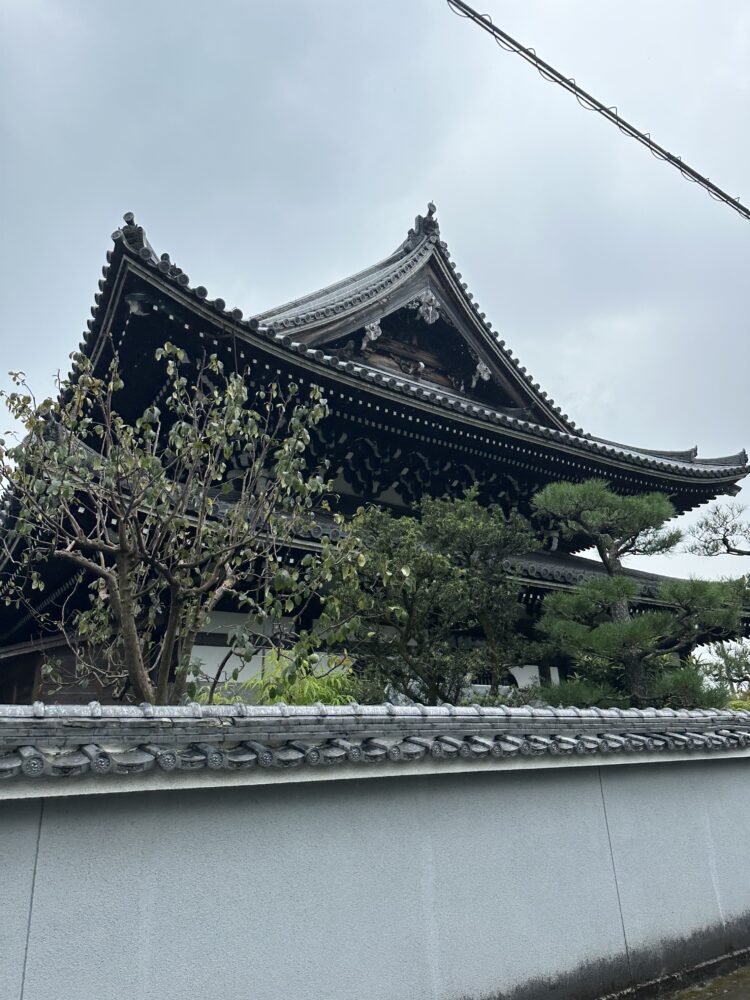
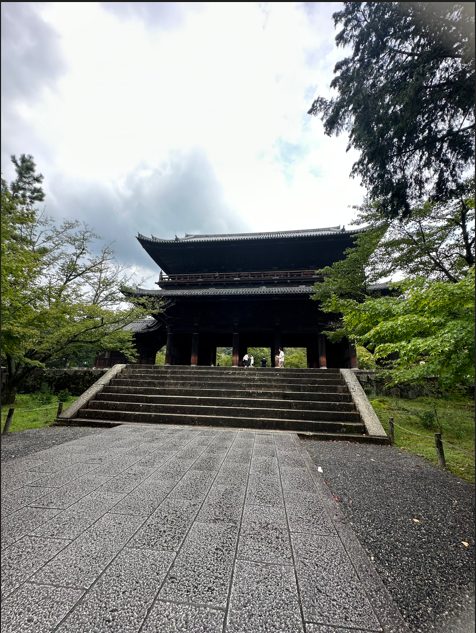
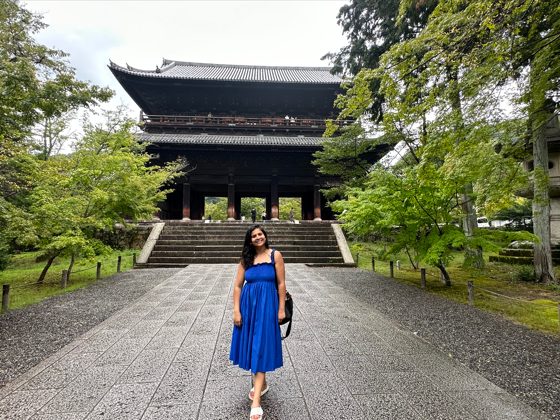
Nanzenji Temple, set at the foot of the wooded Higashiyama mountains in Kyoto, ranks as a key Zen temple in Japan. It serves as the principal temple for a branch of the Rinzai sect of Japanese Zen Buddhism. The temple’s extensive grounds are further expanded by the inclusion of several sub temples, adding to the already expansive complex of temple buildings. The entry fee is 600 Yen.
Timings: The timings to visit this all temple is between 8:40 to 5 and is closed from 28th December to 1st January.
Location: 86 Nanzenji Fukuchicho, Sakyo Ward, Kyoto, 606-8435, Japan
Getting there: Nanzenji Temple is a 5-10 minute walk from Keage Station on the Tozai Subway Line, which is about 20 minutes and 260 yen from Kyoto Station. Alternatively, it’s a similar distance from the Nanzenji-Eikando-michi bus stop, accessible by the Kyoto City Bus number 5 in about 35 minutes for 230 yen from Kyoto Station. The temple is also close to the southern end of the Philosopher’s Path, with Ginkakuji Temple at
Philosopher's path
 The Philosopher’s Path is a charming stone walkway located in the northern area of Kyoto’s Higashiyama district. This path meanders alongside a canal, beautifully lined by hundreds of cherry trees. In early April, these trees burst into vibrant hues, transforming the path into one of Kyoto’s prime spots for hanami (cherry blossom viewing). Stretching for about two kilometers, the journey along this path starts near Ginkakuji (Silver Pavilion) and concludes in the Nanzenji neighborhood. The path is famously associated with Nishida Kitaro, a renowned Japanese philosopher, who is believed to have used this route for meditation during his daily walks to Kyoto University.
The Philosopher’s Path is a charming stone walkway located in the northern area of Kyoto’s Higashiyama district. This path meanders alongside a canal, beautifully lined by hundreds of cherry trees. In early April, these trees burst into vibrant hues, transforming the path into one of Kyoto’s prime spots for hanami (cherry blossom viewing). Stretching for about two kilometers, the journey along this path starts near Ginkakuji (Silver Pavilion) and concludes in the Nanzenji neighborhood. The path is famously associated with Nishida Kitaro, a renowned Japanese philosopher, who is believed to have used this route for meditation during his daily walks to Kyoto University.
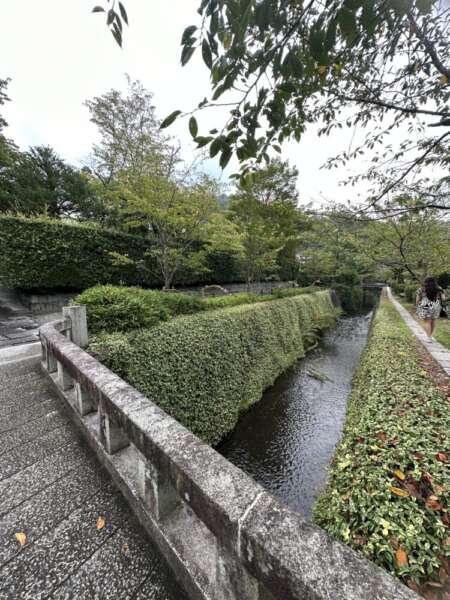 Timings: There are no particular timings
Timings: There are no particular timings
Location: Sakyo Ward, Kyoto, Japan
Getting there: The Philosopher’s Path stretches between Ginkakuji and the Nanzenji neighborhood, situated just a brief 5 to 10-minute stroll north of the primary temple structures of Nanzenji.
Gion
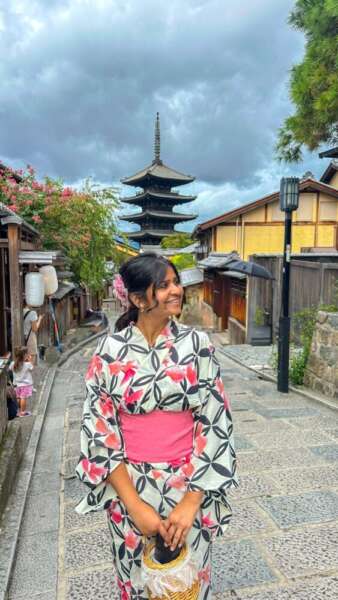 Gion, the historic area is replete with shops, restaurants, and ochaya, where geiko and maiko offer entertainment. Gion is a magnet for visitors due to its abundance of traditional wooden machiya merchant houses. If you are in Kyoto in April, check out the Miyako Odori with daily dance performances by maiko. While dining here can be quite costly, the street and its adjacent alleys are adorned with well-preserved machiya houses, many now serving as restaurants.These establishments offer a range of culinary experiences, from the exquisite Kyoto-style kaiseki ryori (Japanese haute cuisine) to a variety of local and international dishes. The entry charges here are 5500 yen.
Gion, the historic area is replete with shops, restaurants, and ochaya, where geiko and maiko offer entertainment. Gion is a magnet for visitors due to its abundance of traditional wooden machiya merchant houses. If you are in Kyoto in April, check out the Miyako Odori with daily dance performances by maiko. While dining here can be quite costly, the street and its adjacent alleys are adorned with well-preserved machiya houses, many now serving as restaurants.These establishments offer a range of culinary experiences, from the exquisite Kyoto-style kaiseki ryori (Japanese haute cuisine) to a variety of local and international dishes. The entry charges here are 5500 yen.
Timings: There are daily 2 shows and the timings are at 6pm and 8pm.
Location: 570-2 Gionmachi Minamigawa, Higashiyama Ward, Kyoto, 605-0074, Japan
Getting there: To get to Gion from Kyoto Station, one can take bus number 206, which takes about 20 minutes and costs 230 yen, disembarking at the Gion bus stop. Another option is to use the train, with the nearest stations being Gion-Shijo on the Keihan Line and Kyoto-Kawaramachi on the Hankyu Line.
Heian shrine
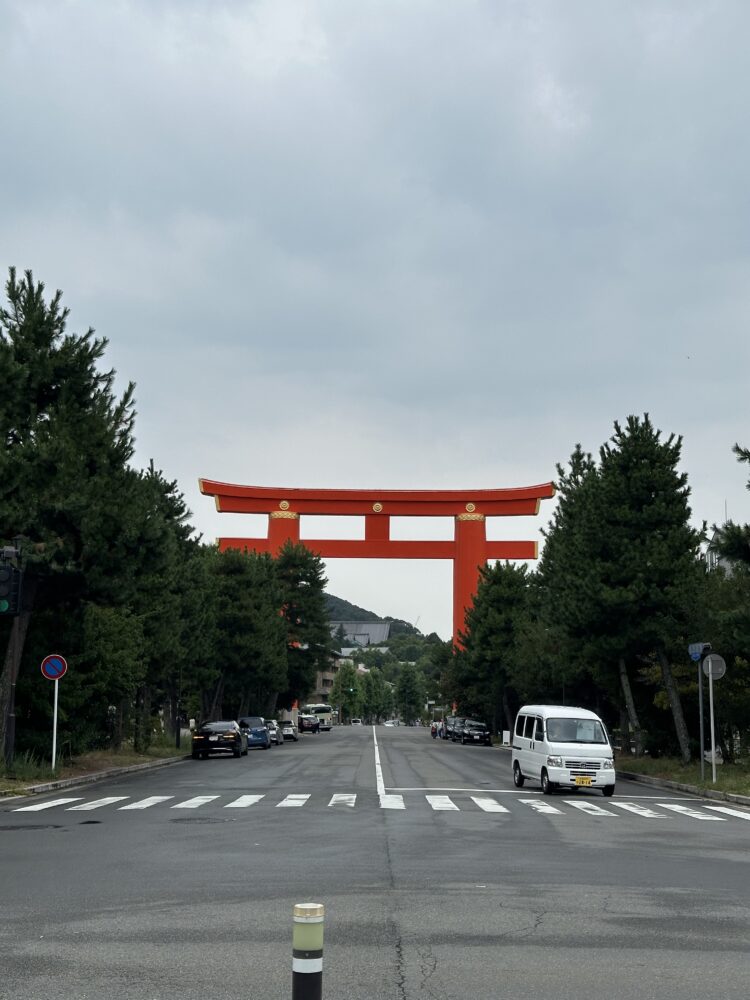
Heian Shrine, with its history spanning just over a century, was established in 1895. This shrine was constructed to commemorate the 1100th anniversary of Kyoto’s establishment as the capital and is dedicated to the spirits of Emperor Kammu (737-806) and Emperor Komei (1831-1867), the first and last emperors to rule from Kyoto. The name ‘Heian’ is actually the former name for Kyoto. A grand torii gate signifies the entrance to the shrine, and in its vicinity, there are several museums.
Timings: The timings vary according to the season which is between 6 am to 6 pm.
Location: 97 Okazaki Nishitennocho, Sakyo Ward, Kyoto, 606-8341, Japan
Getting there: To reach Heian Shrine, one can take the Kyoto City bus number 5 from Kyoto Station, which takes approximately 30 minutes and costs 230 yen. Alternatively, the subway is another option: from Kyoto Station, travel to Karasuma Oike Station, then transfer to Higashiyama Station. This journey takes about 20 minutes and costs 260 yen. From Higashiyama Station, the shrine is just a ten-minute walk away.
Kenninji shrine
Kenninji, a Zen temple, is situated just south of Kyoto’s well-known Gion entertainment district. The temple complex is composed of multiple large halls and gates, surrounded by about two dozen smaller structures. While the majority of Kenninji’s grounds are accessible to the public without charge, there is an entrance fee required to access the main buildings at the heart of the complex. Upon payment, visitors have the opportunity to explore the interiors of these central buildings and take in the beauty of various gravel and moss gardens. The admission fee is 600 yen.
Timings: The timings to visit this place is from 10 am to 5 pm.
Location: Japan, 〒605-0811 Kyoto, Higashiyama Ward, Komatsucho, 584
Getting there: Kenninji Temple is situated at the southern end of Hanamikoji Street in the Gion district. The nearest train stations are Gion Shijo on the Keihan Line and Kyoto-Kawaramachi on the Hankyu Line, both approximately a ten-minute walk from the temple.
Yasaka shrine


Yasaka Shrine, often referred to as Gion Shrine, stands as one of Kyoto’s most renowned shrines. This shrine features a unique architectural design where the honden (inner sanctuary) and haiden (offering hall) are combined into one structure. In front of the main hall is a dance stage, adorned with hundreds of lanterns that are illuminated in the evenings. Each lantern displays the name of a sponsoring local business, symbolizing their donation. Yasaka Shrine is particularly famous for hosting the Gion Matsuri, a prominent summer festival held annually in July.
Timings: The timings are not specific, you can visit anytime.
Location: 625 Gionmachi Kitagawa, Higashiyama Ward, Kyoto, 605-0073, Japan
Getting there: Yasaka Shrine is accessible from Kyoto Station by a roughly 20-minute bus ride. One can take bus number 206 and alight at the Gion bus stop. The nearest train stations are Gion Shijo Station on the Keihan Line and Kawaramachi Station on the Hankyu Line. Additionally, for those who enjoy walking, a highly recommended route is a 20-30 minute stroll from Kiyomizudera through the quaint lanes of the Higashiyama District, leading directly to Yasaka Shrine.
Southern Tokyo
Fushimi Inari shrine


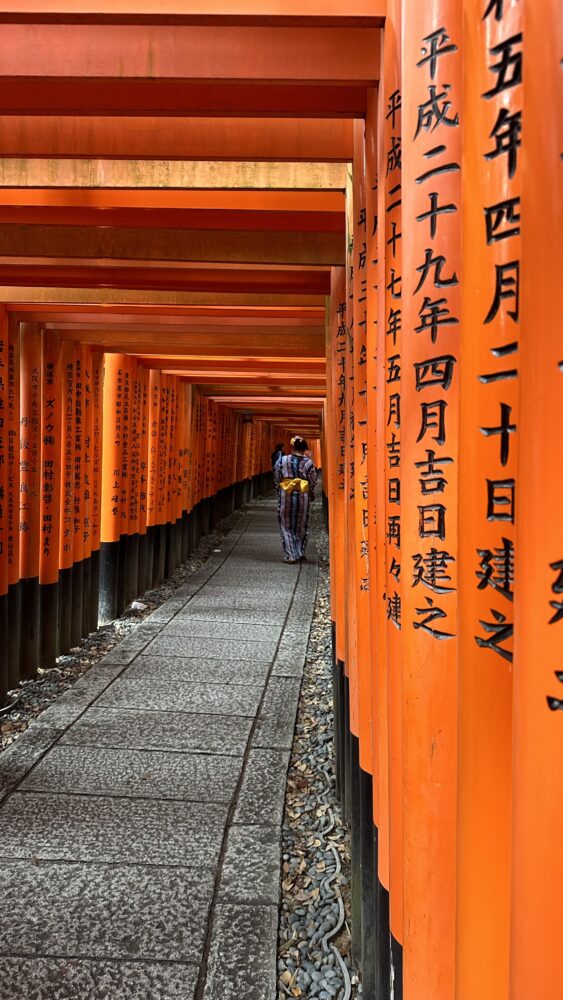
Fushimi Inari Shrine, located in the southern part of Kyoto, is a significant Shinto shrine known for its thousands of striking vermilion torii gates. These gates cover a series of paths behind the shrine’s main structures, winding through the forested area of the revered Mount Inari, which is 233 meters high and part of the shrine’s territory. The shrine’s history is ancient, having been established before Kyoto became the capital in 794.
Timings: There is no mentioned timings, you can visit anytime.
Location: 68 Fukakusa Yabunouchicho, Fushimi Ward, Kyoto, 612-0882, Japan
Getting there: Fushimi Inari Shrine is situated right next to JR Inari Station, which is the second stop from Kyoto Station on the JR Nara Line. The journey takes about 5 minutes and costs 150 yen for a one-way ticket, with the note that rapid trains do not stop at this station. Additionally, the shrine is a brief walk away from Fushimi Inari Station on the Keihan Main Line.
Daigoji temple
Daigoji, a significant temple belonging to the Shingon branch of Japanese Buddhism, is recognized as a World Heritage Site. This expansive temple complex is located to the southeast of Kyoto’s central area and encompasses an entire mountainside. The primary temple structures are situated at the mountain’s base, and a hiking trail links them to additional temple buildings near the mountain’s peak.
Timings: The timings to visit this temple is from 9 in the morning to 5 in the evening.
Location: 22 Daigohigashiojicho, Fushimi Ward, Kyoto, 601-1325, Japan
Getting there: Daigoji Temple is reachable either by a 15-minute walk or a quick ride on community bus number 4 from Daigo Station on the Tozai Subway Line. If you’re coming from Kyoto Station, take a JR train to Yamashina Station, which takes about 5 minutes, and then transfer to the Tozai Subway Line for an 8-minute ride to Daigo Station. Alternatively, from Yamashina Station, you can take Keihan Bus number 22 or 22A, which takes roughly 20 minutes to reach Daigoji. For a direct route from Kyoto Station, the Keihan Bus number 301 offers services to Daigoji, departing once or twice an hour and taking about 30 minutes.
Tofukuji temple
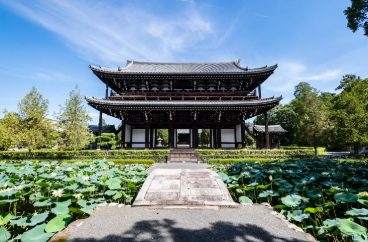
Tofukuji, a prominent Zen temple in the southeastern part of Kyoto, is renowned for its stunning display of fall foliage. Established in 1236 by the influential Fujiwara family, the temple attracts visitors nationwide during autumn to witness its vibrant colors. The most sought-after view is that of the Tsutenkyo Bridge, stretching over a valley filled with maple trees. While several sections of Tofukuji’s temple complex can be accessed without charge, including zones surrounding its most notable and large structures, other parts may require an entrance fee. The admission fees is 600 yen (Tsutenkyo Bridge and Kaisando Hall) 500 yen (Hojo and gardens) 1000 yen (everything).
Timings: The timings are divided accordingly 9:00 to 16:30 (April to October), 8:30 to 16:30 (November to early December), 9:00 to 16:00 (early December to March.
Location:15 Chome-778 Honmachi, Higashiyama Ward, Kyoto, 605-0981, Japan
Getting there: Tofukuji can be reached with a ten-minute walk from Tofukuji Station, which is serviced by both the JR Nara Line (a brief 2-minute journey costing 150 yen from Kyoto Station) and the Keihan Main Line. Another option is to walk from the Tofukuji bus stop, accessible by the Kyoto City Bus 208 from Kyoto Station in about 15 minutes for 230 yen.
Toji temple
Toji Temple, whose name translates to “East Temple,” was established in the early Heian Period, shortly after Kyoto became the capital in the late 700s. This significant temple, along with the no longer existing Saiji or “West Temple,” stood at the southern gateway of the city, acting as protector temples for the capital. Toji Temple is recognized as one of the numerous UNESCO World Heritage Sites in Kyoto. The entry charge is 500 yen and 800 on special opening of pagoda.
Timings: The timing is 8 in the morning to 5 in the evening.
Location: 1 Kujocho, Minami Ward, Kyoto, 601-8473, Japan
Getting there: Toji is conveniently located a 15-minute walk to the southwest from Kyoto Station. As an alternative, it’s just a five-minute stroll from Toji Station on the Kintetsu Kyoto Line, which is a quick 2-minute, 180 yen ride from Kyoto Station.
Fushimi sake district

The Fushimi Sake District is a picturesque and traditional sake-producing area situated alongside the scenic Horikawa River in southern Kyoto. Renowned for the pristine and gentle waters that emerge abundantly from the underground springs of the river, this district boasts nearly 40 sake breweries. Alongside Kobe’s Nada District, Fushimi has held a prominent position as a key sake brewing hub in Japan for countless centuries.
Timings: There is no particular timing to visit this place.
Location: 82番2 Hiranocho, Fushimi Ward, Kyoto, 612-8057, Japan
Getting there: You can easily reach the attractions around the Fushimi Sake District with a short 5-10 minute walk from Chushojima Station on the Keihan Main Line, Fushimi-Momoyama Station on the same line, or Momoyama Goryomae Station on the Kintetsu Kyoto Line. Additionally, it’s a 15-20 minute walk from Momoyama Station on the JR Nara Line.
Northern Tokyo
Kinkakuji
Kinkakuji, also known as the Golden Pavilion, is a Zen temple in northern Kyoto famous for its top two floors covered in gold leaf. It was originally a shogun’s retirement villa and later transformed into a Zen temple. Visitors can explore the temple, including the Sekkatei Teahouse, and enjoy matcha tea in the tea garden. Outside, there are souvenir shops and Fudo Hall, which houses a statue of Fudo Myoo, a Buddhist guardian. The admission fee is 500 Yen.
Timings: The timing is from 9 am to 5 pm.
Location: 1 Kinkakujicho, Kita Ward, Kyoto, 603-8361, Japan
Getting there: To reach Kinkakuji from Kyoto Station, you can take Kyoto City Bus number 205 directly, which takes about 40 minutes and costs 230 yen. Alternatively, a quicker and more dependable option is to use the Karasuma Subway Line to Kitaoji Station (15 minutes, 260 yen) and then proceed to Kinkakuji by taxi (approximately 10 minutes, around 1300 yen) or by bus (around 10 minutes, 230 yen) using bus numbers 204 or 205.
Shugakuin Imperial Villa
Constructed during the 17th century by Emperor Gomizuno, the Shugakuin Imperial Villa is presently under the supervision of the Imperial Household Agency. This expansive villa comprises three sections: the Upper, Middle, and Lower Villas, each showcasing gardens and structures designed in the traditional imperial style.
Timings: The timings are from 8:40 to 5 and Mondays are closed.
Location: Shugakuin Yabusoe, Sakyo Ward, Kyoto, 606-8052, Japan
Getting there: Shugakuin Imperial Villa is closest to Shugakuin Station on the Eizan Railway Line, a 10 to 15-minute walk away. From Kyoto Station, you can take the JR Nara Line to Tofukuji, transfer to the Keihan Line to Demachiyanagi, and then take the Eizan Railway to Shugakuin. The whole trip costs 650 yen and takes about 40 minutes.
Ninnaji temple

Ninnaji is among Kyoto’s distinguished temples designated as World Heritage Sites. Serving as the principal temple of the Omuro School within the Shingon sect of Buddhism, it was established in 888 by the reigning emperor. Ninnaji is also renowned for its grove of locally cultivated cherry trees known as Omuro Cherries, which bloom later than usual. Entrance to the Goten palace buildings at Ninnaji costs 800 yen. The rest of the temple grounds are usually free to access, except during the cherry blossom season when a 500 yen admission fee is charged.
Timings: The timings to enter this temple is this 9:00 to 17:00 (until 16:30 from December to February)
Location: 33 Omuroouchi, Ukyo Ward, Kyoto, 616-8092, Japan
Getting there: Ninnaji Temple is a brief 10-minute walk from Ryoanji Temple and is close to Omuro Ninnaji Station on the Keifuku Kitano Line. From Kyoto Station, you can reach Ninnaji by taking a direct JR bus, which takes about 30 minutes and costs 230 yen. Various JR passes and Kyoto’s one-day bus pass cover the bus fare, and buses run every 15-30 minutes.
Kibune
Kibune is a quaint town nestled in a lush valley within Kyoto’s northern mountains, centered around Kifune Shrine. Kifune Shrine is devoted to the deity of water and rain, regarded as the guardian of seafarers. One of its distinctive features is the opportunity to receive unique fortunes written on paper slips (omikuji), which reveal their messages when immersed in water.
Timings: The timings are from 6 am to 8 pm.
Location: It is a small town in Kyoto.
Getting there: To reach Kibune, take the Eizan Railway’s Kurama Line from Demachi-Yanagi Station in central Kyoto. It’s a 30-minute ride costing 470 yen, with trains every 15-20 minutes. From Kibune-guchi Station, a five-minute bus ride (170 yen) or a 20-30 minute walk gets you to Kifune Shrine. To get to Demachi-Yanagi Station from Kyoto Station, take the JR Nara Line to Tofukuji Station (150 yen, 2 minutes), then transfer to the Keihan Main Line to reach Demachi-Yanagi Station (280 yen, 10 minutes).
Kurama
Kurama is a picturesque town situated in the northern mountains of Kyoto City, reachable in less than an hour from the city center. The town’s focal point is Kurama-dera, a Buddhist temple perched on the steep, forested mountainside overlooking the town. It typically takes 30-45 minutes to ascend from the town to the temple’s primary structures. Kurama is renowned for being home to Kurama Onsen, one of Kyoto’s conveniently reachable hot springs.
Timings: The timings are from 9 am to 4:15 pm.
Location: 1074 Kuramahonmachi, Sakyo Ward, Kyoto, 601-1111, Japan
Getting there: Kurama is conveniently linked to central Kyoto via the Eizan Railway. The journey along the Eizan Kurama Line from Demachi-Yanagi Station to Kurama Station takes approximately 30 minutes and costs 470 yen, with trains running every 15-20 minutes. To reach Demachi-Yanagi Station from Kyoto Station, the quickest route is to take the JR Nara Line to Tofukuji Station (150 yen, 2 minutes), then transfer to the Keihan Main Line for a 10-minute ride to Demachi-Yanagi Station (280 yen).
Ryoanji
Ryoanji Temple is renowned for hosting Japan’s most prominent rock garden. It was initially constructed as an aristocrat’s villa during the Heian Period. The temple’s extensive grounds encompass a generous park area with a pond, situated beneath the temple’s principal structures. This pond harks back to the era when the site functioned as an aristocratic villa and includes a petite shrine on one of its three small islands, reachable via a bridge. The entry fee is 500 Yen.
Timings: The timings are 8:00 to 17:00 (March to November) and 8:30 to 16:30 (December to February)
Location: 13 Ryoanji Goryonoshitacho, Ukyo Ward, Kyoto, 616-8001, Japan
Getting there: To get to Ryoanji, you can take a JR bus directly from Kyoto Station, a 30-minute ride costing 230 yen, covered by various rail passes. Buses run every 15-30 minutes. Alternatively, it’s a five-minute bus ride or 20-minute walk from Kinkakuji. You can also use the Keifuku Kitano Line, a small train that connects to Ryoanji-michi Station, a 5-10 minute walk from the temple.
Ohara
Ohara, a quaint town situated in the mountainous region of northern Kyoto, remains within the boundaries of Kyoto city despite being an hour’s journey from Kyoto Station. The town is renowned for the Sanzenin Temple and attracts many visitors in mid-November for its spectacular autumn foliage, which typically appears a week earlier than in central Kyoto. The walkway leading to the temple is dotted with a variety of small shops. Among the local delicacies available is aisu kyuri, a unique snack comprising cucumbers marinated in seaweed-infused ice water and served skewered.
Timings: There is no particular timing to visit this place.
Location: Ohara is a village in Kyoto.
Getting there: To reach Ohara from Kyoto Station, take the Karasuma Subway Line to Kokusaikaikan (20 minutes, 290 yen), then Kyoto Bus number 19 to Ohara (20 minutes, 360 yen, every 40 minutes). Alternatively, use Kyoto Bus number 17 directly from Kyoto Station to Ohara (60 minutes, 560 yen, every 20 minutes), passing through Shijo-Kawaramachi (45 minutes, 530 yen). Note: these bus rides are not included in the 1-day bus pass.
Sanzenin temple
Sanzenin Temple stands as the primary highlight in Ohara, a quaint town situated roughly an hour to the north of Kyoto’s central area. The path leading from the Ohara bus stop to Sanzenin is adorned with a variety of shops and eateries, all serving those visiting the temple. Additionally, several smaller temples can be found nearby. The temple complex of Sanzenin itself boasts expansive grounds, encompassing numerous structures, landscaped gardens, and scenic walking trails.
Timings: The timings to visit this place is 8:30 to 17:30 (March to December 7), 9:00 to 17:00 (December 8 to February) Location: 540 Ohararaikoincho, Sakyo Ward, Kyoto, 601-1242, Japan Getting there: Sanzenin Temple is a 10-minute walk uphill from the Ohara bus stop. To get to Ohara from Kyoto Station, take the Karasuma Subway Line to Kokusaikaikan (20 minutes, 290 yen), then Kyoto Bus number 19 (20 minutes, 360 yen, every 40 minutes). Alternatively, use Kyoto Bus number 17 directly from Kyoto Station (60 minutes, 560 yen, every 20 minutes), passing through Shijo-Kawaramachi (45 minutes, 530 yen). Note that these bus trips are not covered by the 1-day bus pass.
Takao
Takao, a secluded and mountainous region, is home to three ancient temples nestled in its wooded valley. Located about an hour’s bus journey to the north of Kyoto’s central area, Takao is an attractive destination throughout the year. However, it gains particular popularity during the peak of the autumn foliage, typically around mid-November. The admission fee to enter is 400 Yen.
Timings: The timings to visit this place is 9 am to 4 pm.
Location: Uji, Kyoto 611-0013, Japan
Getting there: Takao, part of Kyoto’s flat-fare zone since 2021, is reachable via JR buses and Kyoto City Bus, both included in Kyoto’s one-day bus pass. JR buses leave Kyoto Station for Takao every 20-30 minutes, with a 50-minute journey costing 230 yen, and also service JR Nijo Station and Ninnaji. They are also covered by the Japan Rail Pass and several JR West rail passes. Alternatively, Kyoto City Bus number 8 from Shijo-Karasuma, running every 30-60 minutes, takes 45 minutes at the same fare. Buses stop at Takao and Toganoo, serving Jingoji, Saimyoji, and Kozanji, with some JR buses going further into the valley.
Kitano Tenmangu Shrine
Kitano Tenmangu Shrine stands out among the numerous shrines throughout Japan devoted to Sugawara Michizane, a revered scholar and politician unjustly banished by his adversaries. This shrine is not only famous for its tobiume tree but also boasts a vast orchard of about 2,000 plum trees that flower from February to March. Additionally, Kitano Tenmangu holds a unique tea ceremony known as Baikasai. On the 25th of each month, the shrine and its adjacent streets come alive with a bustling flea market.
Timings: The timings to visit this place is 5:00 to 18:00 (April to September) and 5:30 to 17:30 (October to March)
Location: Bakurocho, Kamigyo Ward, Kyoto, 602-8386, Japan
Getting there: You can access Kitano Tenmangu Shrine straight from Kyoto Station using Kyoto City Bus number 50 (230 yen, 30 minutes). Alternatively, especially during peak traffic times, you might find it faster to take the Karasuma Subway Line to Imadegawa Station and then switch to bus 203 heading to the shrine. For both routes, disembark at the Kitano Tenmangu-mae bus stop.
Western Tokyo
Arashiyama
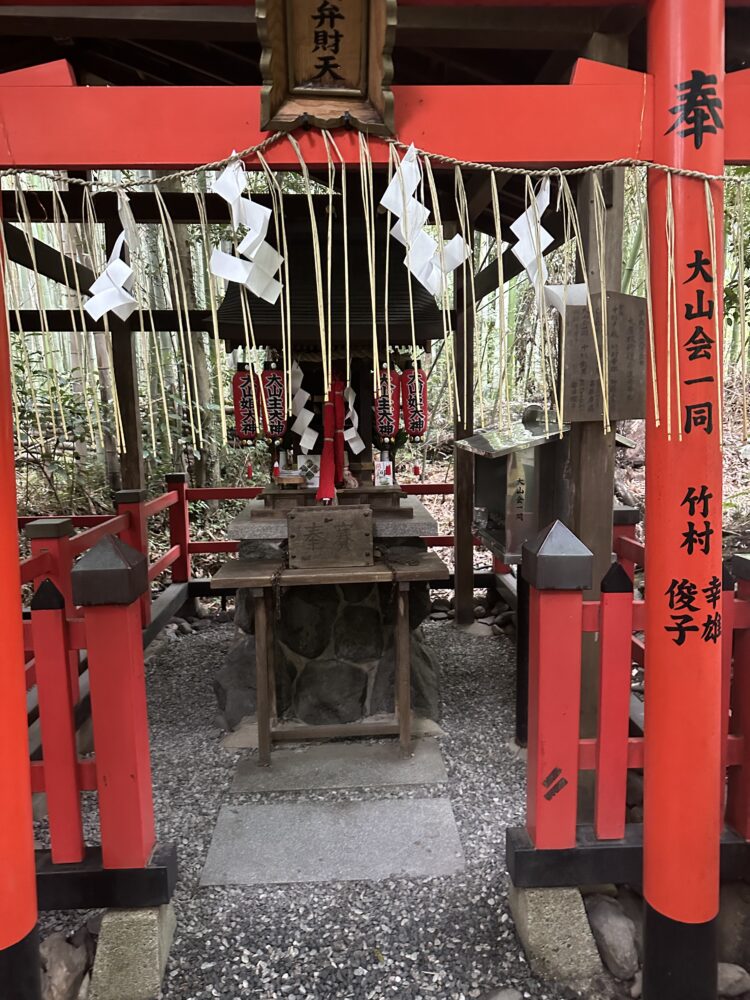
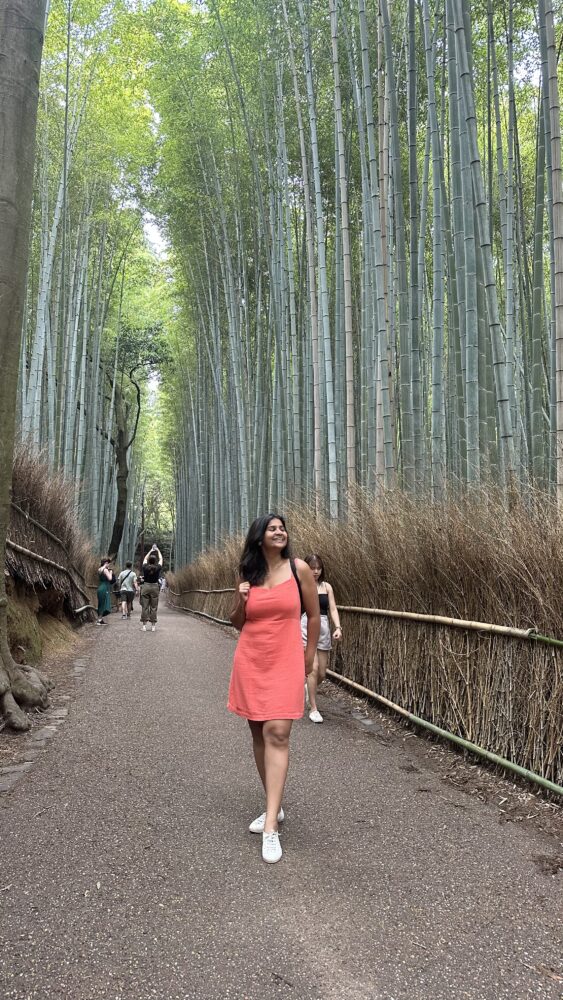
Arashiyama, located in Kyoto’s western outskirts, is a charming and tourist-friendly area. It has been a favored spot since the Heian Era (794-1185), known for its scenic beauty which attracted the ancient nobility. The district is especially beloved during the cherry blossom and autumn foliage seasons. At the heart of Arashiyama is the iconic Togetsukyo Bridge. Surrounding this landmark are numerous quaint shops, eateries, and attractions including the renowned Tenryuji Temple, the famous bamboo groves of Arashiyama, and the option to rent pleasure boats on the river.
Timings: There are no particular timings to visit this place.
Location: Ukyo Ward, Kyoto, 616-0007, Japan
Getting there: The quickest route from Kyoto Station to Arashiyama is via the JR Sagano (or Sanin) Line, with a 15-minute journey to Saga-Arashiyama Station costing 240 yen, followed by a short 5-10 minute walk to the heart of Arashiyama. Alternatively, the Keifuku Arashiyama Line links Arashiyama to Omiya Station in central Kyoto at Shijo Street (20 minutes, 250 yen) and also connects to Kitanohakubaicho Station near Kyoto’s northern temples like Kinkakuji, with a transfer required en route. The Keifuku Arashiyama Station is centrally located in Arashiyama. From central Kyoto’s Kyoto-Kawaramachi or Karasuma Stations, the Hankyu Main Line goes to Katsura Station; switch there to the Hankyu Arashiyama Line for a 20-minute, 240 yen trip to Hankyu Arashiyama Station, situated a brief walk across the river from central Arashiyama. While driving isn’t recommended due to congestion and parking challenges, those with cars visiting Takao can use the Arashiyama Takao Parkway toll road (1200 yen one way) for access.
Kokedera
Saihoji, often called Kokedera, is recognized as a UNESCO World Heritage Site in Kyoto. Visiting this temple necessitates a prior reservation. The name ‘Kokedera’ translates to ‘Moss Temple’, a nod to its garden which is home to around 120 types of moss. Except during winter months, visitors have the opportunity to explore this magnificent garden, a significant inspiration for later Japanese garden designs. The entry fees is 4000 yen and plus 110 yen for service fee.
Timings: There is no particular timing to visit this place but it require prior reservation, atleast before 1-2 month of visiting.
Location: 56 Matsuojingatanicho, Nishikyo Ward, Kyoto, 615-8286, Japan
Getting there: To visit Kokedera, take a 20-minute walk from Matsuo Taisha Station on the Hankyu Arashiyama Line. The journey involves a 3-minute ride on the Karasuma Subway Line to Shijo Station, an 8-minute transfer to the Hankyu Kyoto Line to Katsura Station, and a final 5-minute ride on the Hankyu Arashiyama Line. The total travel time is about 30 minutes, costing 460 yen. Alternatively, Kyoto Bus number 73 from Kyoto Station to Kokedera, via Arashiyama, takes about an hour and costs 230 yen, but is not covered by the 1-day bus pass and may face delays on busy days.
Katsura Imperial villa
Katsura Imperial Villa stands as a prime illustration of traditional Japanese architectural and garden design. Established in 1645, it served as the home for the Katsura Family, who were part of the Imperial Family of Japan. To visit, one must participate in a guided tour that encompasses a circular path around the garden’s central pond. While visitors can only observe the palace buildings from the exterior, photography is permitted at specific locations. English language tours are offered. The cost per person is 1000 yen and it should be booked indeed in advance.
Timings: The timings to visit this place is 8:40 to 5 in the evening and it remains close on Monday.
Location: Katsuramisono, Nishikyo Ward, Kyoto, 615-8014, Japan
Getting there: Katsura Rikyu, situated in Kyoto’s western region, is a mere 15-minute walk from Katsura Station, located on the Hankyu Kyoto Line. You can also opt for Kyoto City Bus number 33 from Kyoto Station, which takes around 20 minutes to reach the villa. Disembark at the “Katsura Rikyu-mae” stop. This bus journey costs 240 yen and isn’t entirely included in the Kyoto City Bus One Day Card, with buses running approximately every 30 minutes. Another option is to use Keihan Bus services 2 and 26 to reach the destination.
Yoshiminedera
Yoshiminedera, a Tendai Buddhist temple, is nestled in the western mountains of Kyoto. Much like Kiyomizudera, located on the city’s opposite side, it is perched along the slope of a mountain, offering views over Kyoto. The temple complex is expansive, with numerous structures scattered up the mountainside. Among its notable features are several venerated trees, including a distinctive pine tree that is around 600 years old, measuring just 2 meters in height but spanning an impressive 40 meters in width. The entry fee is 500 Yen.
Timings: The timing to visit this place is 8:30 to 17:00 (from 8:00 on weekends and public holidays).
Location: 1372 Oharano Oshiocho, Nishikyo Ward, Kyoto, 610-1133, Japan
Getting there: You can access Yoshiminedera by first taking the JR Kyoto Line from Kyoto Station to Mukomachi Station (a 7-minute ride costing 190 yen) or by using the Hankyu Kyoto Line from central Kyoto to Higashimuko Station (20 minutes, 240 yen). From either station, Hankyu Bus #66 will take you to the temple in about 30 minutes for a fare of 390 yen, with buses running hourly. However, from early January to February, these buses only go as far as Koshio near Jurinji Temple, leaving a remaining distance of 1.5 kilometers to Yoshiminedera, which equates to a walk of about 20-30 minutes.
Daikakuji Temple
Daikakuji, a sizeable temple, is located in Sagano, a northern area of Kyoto. Initially constructed in the early 9th century, it served as the separate palace of Emperor Saga, who appreciated the tranquility of this region on Kyoto’s periphery. Three decades following the emperor’s passing, the palace was transformed into a temple, and it has remained a prominent temple of the Shingon Buddhist sect ever since.
Timings: The timings to visit this temple is from 9 to 5
Location: 4 Sagaosawacho, Ukyo Ward, Kyoto, 616-8411, Japan
Getting there: Daikakuji can be reached with a 15-minute walk heading north from JR Saga-Arashiyama Station, which is a 15-minute, 240 yen journey from Kyoto Station, or it’s a 25-minute walk from Keifuku Arashiyama Station. As an alternative, you can opt for bus number 91 from Saga-Arashiyama Station, a 5-minute trip costing 230 yen with buses departing every 20 minutes, or take bus number 28 from central Arashiyama, which takes about 10 minutes and also costs 230 yen, with buses available every 20 minutes.
Tenryuji temple
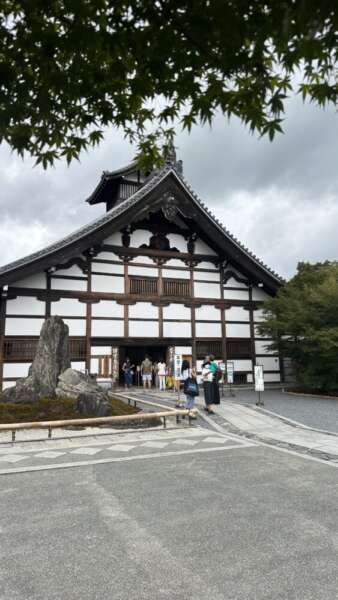 Tenryuji holds the distinction of being the premier temple in the Arashiyama area of Kyoto. It enjoys the top spot among the city’s five major Zen temples and has been designated as a World Heritage Site. Additionally, it serves as the principal temple of a distinct school within the Rinzai Zen branch of Japanese Buddhism.The entry fees is 500 yen and if visiting to a temple then additional 300 yen.
Tenryuji holds the distinction of being the premier temple in the Arashiyama area of Kyoto. It enjoys the top spot among the city’s five major Zen temples and has been designated as a World Heritage Site. Additionally, it serves as the principal temple of a distinct school within the Rinzai Zen branch of Japanese Buddhism.The entry fees is 500 yen and if visiting to a temple then additional 300 yen.
Timings: The timings are from 8:30 to 5 in the evening.
Location: Japan, 〒616-8385 Kyoto, Ukyo Ward, Sagatenryuji Susukinobabacho, 68
Getting there: Tenryuji is conveniently located just a brief stroll away from Keifuku Arashiyama Station, which is served by the compact Keifuku (or Randen) trains, linking it with the Ryoanji/Kinkakuji area and Omiya Station on Shijo-dori Street. Alternatively, the temple is accessible via a 5-10 minute walk from JR Saga-Arashiyama Station, a short 10-15 minute ride costing 240 yen one way from Kyoto Station
Toei Uzumasa Eigamura
The Toei Uzumasa Eigamura, often referred to as Kyoto Studio Park, combines a movie set and a theme park. This unique attraction replicates a town from Japan’s feudal era and houses a range of traditional structures that are frequently utilized as scenic backdrops for shooting historical films and TV dramas. The entry charge is 2400n yen.
Timings: It starts around 9 or 10 in the morning till 5 in the evening
Location: 10 Uzumasa Higashihachiokacho, Ukyo Ward, Kyoto, 616-8586, Japan
Getting there: The Toei Eigamura is conveniently located just a five-minute stroll from Uzumasa-Koryuji Station on the Keifuku Arashiyama Line, which is a 10-minute, 250 yen ride from either Shijo-Omiya or Arashiyama. Alternatively, it’s a 15-minute walk from JR Hanazono Station, a brief 10-minute and 200 yen journey from Kyoto Station. Additionally, you can reach the park in about 30 minutes using Kyoto City Bus 75 or Kyoto Bus 73, 76, or 83 from Kyoto Station. Buses such as Kyoto City Bus 11 or 91 or Kyoto Bus 63 or 66 from Shijo/Kawaramachi also provide access to the park.
Hozugawa river cruise
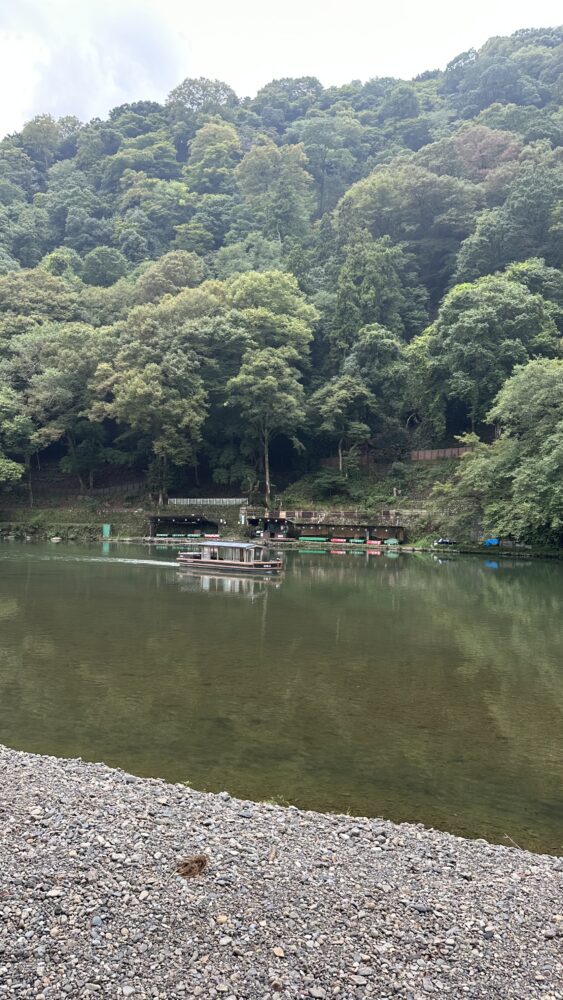
Hozugawa River Cruises offer scenic boat tours along the Hozugawa River, traveling from Kameoka to Arashiyama. These cruises feature traditional, flat-bottomed boats, steered by skilled boatmen using oars and bamboo poles. The journey down the river takes approximately two hours, offering a tranquil experience amidst the natural beauty of the mostly untouched ravine. Often, these river cruises are paired with a journey on the Sagano Scenic Railway for a comprehensive sightseeing experience.
Timings: Timings to this river cruise is 9:00 to 15:00 (March 10 to December 13, hourly departures), 10:00 to 14:30 (December 14 to March 9, departures every 90 minutes).
Location: Japan, 〒621-0005 Kyoto, Kameoka, Hozucho, Shimonakajima−2
Getting there: Cruises set off just a brief bus journey (170 yen) or a ten-minute walk away from JR Kameoka Station, which itself is a 20-30 minute ride costing 420 yen from Kyoto Station. Alternatively, you can reach the pier by taking a 15-minute, 310 yen bus ride from Torokko Kameoka Station, the final stop of the Sagano Scenic Railway starting from Arashiyama. The boats conclude their journey in Arashiyama, arriving a short distance upstream from the well-known Togetsukyo Bridge.
Yamazaki Whisky Museum
The Yamazaki Whisky Museum is a two-story facility that delves into the history of the Suntory company, its founder Shinjiro Torii, and its products. The second floor features miniature models explaining the whisky distillation process, complete with English descriptions. The museum also has a second-floor gift shop offering whisky-related items and small bottles of un-aged whisky. It is a 3000 yen guided tour.
Timings: The timings are from 10 am to 4:45 pm.
Location: 5 Chome-2-1 Yamazaki, Shimamoto, Mishima District, Osaka 618-0001, Japan
Getting there: The Suntory Yamazaki Distillery is in the Yamazaki district near Kyoto and is easily accessible. It’s a short 10-minute walk from either Yamazaki Station on the JR Kyoto Line (15 minutes from Kyoto Station) or Oyamazaki Station on the Hankyu Kyoto Line (30 minutes from Kyoto-Kawaramachi Station).

